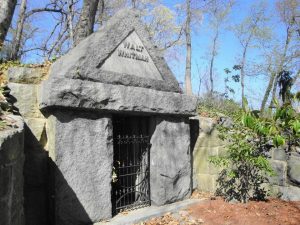Exploring the Foundations of Walt Whitman’s Tomb

Many a fan of Walt Whitman endeavors to undertake a pilgrimage to Camden, New Jersey, to see the home of the man on Mickle Street. But, of course, no visit is really complete without a stop at the final resting place of the Good Gray Poet in Harleigh Cemetery. A visit to Whitman’s tomb shows a rough-hewn stone mausoleum tucked off to the side of the graveyard, built into a wooded hill – exactly the place Whitman chose to rest. In the burial house lie the poet and a number of his family – exactly as Whitman wanted them to lay. This is by no means out of the ordinary for any person. But, for Whitman, there is always more to the story. How did this final resting place come to be? Walt Whitman could have been found anywhere – he wrote, “I bequeath myself to the dirt to grow from the grass I love, If you want me again look for me under your boot-soles.” But here he rests in Camden.
Whitman, famously, said his arrival in Camden “was originally an accident.” He moved to the city in 1873, at fifty four. He stayed with his brother George, due to his health. He ended up in Camden for nearly two decades. Health permitting, he wrote, travelled, made a series of important friends, and lived his last days in the city. Camden brought him “blessed returns.” On May 31, 1889, friends and admirers threw him a huge 70th birthday party in Camden. Proceedings were published as Camden’s Compliment to Walt Whitman. One of the speeches contained therein was given by Thomas Harned, one of his great Camden friends. Harned’s topic was “Camden: Our Fellow-Citizen.”
Among his statements that day:
Our citizenship is raised because in our city lives the author of “Leaves of Grass.”
… he is visited by persons of prominence from all parts of the world. This city to-day is known to thousands of persons in distant lands merely because it is the home of Walt Whitman.
Camden will be best known and honored because it has known and honored Walt Whitman. Succeeding generations will do him reverence, and the little frame-house on Mickle street will be a shrine toward which pilgrims will travel in their adoration of him as one of the world’s immortals.
All that Harned said has proven to be true over thirteen decades later. However, there is always more to the tale.
The story of Whitman choosing to be buried in Camden in the crypt of his own design is a story that has many a twist and turn. Whitman’s last days and the construction of his burial house provide a fascinating view of the man of whom Tom Harned said, “Does not such a life baffle our understanding?” In the Walt Whitman Association journal, Conversations, the tomb’s story is chronicled across three articles which tell of the Whitman tomb from concept to creation, from Whitman’s last days and funeral to the controversy that has dogged the vault. We invite you to read these articles and follow this fascinating narrative in detail.
| “We Do Not Entomb You or Bid You Farewell: Walt Whitman’s Last Days, Last Celebrations and Lasting Traditions”
by Matthew L. Ifill Click below to read |
The first of these details the last days of Whitman’s life and the grand funeral that followed- a viewing at the home, a procession to the grave, a series of eulogies and readings. It was a fitting sendoff to the poet who had inspired so many lives. |
| “The Rudest Most Undress’d Structire (with an idea) Since Egypt: The Story of Walt Whitman’s Tomb, Harleigh Cemetery, Camden NJ”
by Matthew L. Ifill Click below to read |
The second article examines the tomb and its creation. It started with the offer of a plot at the new local cemetery, Harleigh. Whitman was told to pick out any spot he wanted. He chose a quiet corner and decided on a grand stone mausoleum with a design inspired by fellow poet (and illustrator) William Blake. Whitman drew the first sketch. He sent friends out to visit the site under construction and sent professional photographs to those who could not come in person. Whitman felt the whole thing had a meaning- even though some felt it was unfitting to have a grand tomb for a simple soul. |
| “The Tomb Affair: The Monetary and Legal Wranglings over Walt Whitman’s Resting Place, and the Question of Who Really is Buried in Whitman’s Tomb”
by Matthew L. Ifill Click below to read |
The final article deals with the controversary that arose about the cost of the tomb. This became a weight on the poet in his later days. He began to feel he was being cheated by the builders and the cemetery. His friend and lawyer, Tom Harned, took up the fight for the aged writer. The last part of the story revolves around Whitman’s plans for the occupants of the tomb, such as his parents and perhaps some of his children, who add to the mystery. |
| Walt Whitman’s Tomb Contract
Click below to view |
Here you may view the Tomb Contract document which figures prominently in the events described in Conversations (Winter 2016-17) . |
For those interested in Walt Whitman – especially his time on Camden- these three articles offer a fascinating glimpse into the life and death of this complicated man. See for yourself if such a man “baffles our understanding.” For anyone who has visited the grave, or intends to, these pieces offer a great context to this part of the tale of Whitman and Camden.
